PLEASE NOTE: This project is a precis of a larger article currently under edit and tentitive permissions. Unless otherwise noted, all quotes and images herein belong to their respective owners. All material not marked "in the public domaain" or containing a Creative Commons or similar designation for use are the copyright © property of their owners and may not be reproduced without their expressed written permission.
Created for Janice
My Stuff, My Things
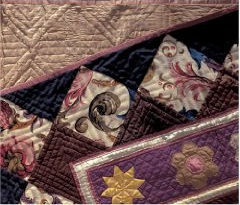
Seen above is a selection from the Winterthur Collection
"Isn't this just too cool?" is a question sometimes asked of us by others who's hobby is, to them, a source of comfort and ease; a time to relax and just, if for
only a few moments, get away from the troubles or stresses of life that seem to pop in as regular as the monthly bills. Sometimes though, we do it just for the pure
enjoyment of the "hobby" and that's enough for us. Sometimes it's nice when others, seeing that enjoyment, also take a geniune interest, especially in the
results of our love for that which we have created.
"Um, I guess so, never thought about it and therefore have no opinion as I don't know a thing about it." Okay, honest enough answer.
We often discover that life offers more than we thought at first, especially when we stop a moment and admire the beauty and dedication of another's moment, a moment
when they pause to enjoy life themselves. The real value in another's hobby can be more appreciated when one considers that, what has been created was often times done
without having ever been asked or even paid to do so. The real beauty and bonus of our hobbies is that we pursue them without the imposition that life's responsibilities
require of us, that laborious necessity we call "work". There really is no down side to taking a moment to learn more about the world around us, who knows? You
might end up with your own version of the hobby. With that said, the above answer is often taken to mean that you have no interest in what another is really "in to" and
therefore, without further gilding the lilly here, no true interest in the other person.
As for myself, a good snap shot of a distant galaxy from the Hubble Space Telescope is my "cool". And, since I'm also into stamp collecting, that rare variety
accquired on eBay at below catalog is often times a source of "Isn't this very cool". I say this because I was recently reminded of these facts by a good friend
whose hobby happens to be quilting. Now, having grown up and travelled down the "mui macho" path of life, my response and thoughts on quilting we're pretty
much the same as the above answer might indicate: "Yeah, works for you but...and we'll leave it there." And when put in that context, the above answer seems
rather callous, a sort of "get me off this topic right away" excuse of advoiding something we really don't understand at all. In turn, this oftens becomes, for the
other, just another "why even bother with it" moment. For the sake of friendship, I cannot live with that
I was reminded of this in a recent eMail, in a single succicnt line that at first, was going to receive my ususal trite response to such things not "mui macho". After
giving it some thought however, I realized that perhaps it would be better to find out if I really felt that way about her hobby which, in this case, is quilting. So I did what I do
best, I went exploring and as a result of that, I put aside my interests for a moment to find what is behind her love of the hobby; perhaps becoming a little wiser, a little more
caring and honoring of her moment when nothing else matters but a little quiet time with the thing she loves most to do — Quilting. I hope so.
An interesting Study into the Past
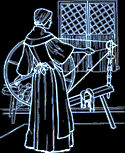 Sewing and the fabrication of cloth, the spinning of thread or yarn for the creation of
warmth and protection against the elements stands as the driving force behind today's apparel and the things we make in order to provide that. This has been true through the
ages, whether the results were the corse burlap material of medieval Europe or the necessities of life itself in our own country's colonial times; an era that has given much to
the rise and style to the hobby of Quilting. For us, the journey begins there, in the harsh dwellings, humble homes of the early settlers of this country, before electricity,
convience stores, Sears catalogs and the internet. It ends in the warm back rooms of our homes, with closets full of materials, patterns and the ideas and love that are
handed down as the traditions of the family.
Sewing and the fabrication of cloth, the spinning of thread or yarn for the creation of
warmth and protection against the elements stands as the driving force behind today's apparel and the things we make in order to provide that. This has been true through the
ages, whether the results were the corse burlap material of medieval Europe or the necessities of life itself in our own country's colonial times; an era that has given much to
the rise and style to the hobby of Quilting. For us, the journey begins there, in the harsh dwellings, humble homes of the early settlers of this country, before electricity,
convience stores, Sears catalogs and the internet. It ends in the warm back rooms of our homes, with closets full of materials, patterns and the ideas and love that are
handed down as the traditions of the family.
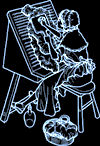 "After colonial settlers became established in America an ordinary woman's
daily life was still difficult. Typically she would be expected to do the spinning, sewing, food preservation, cooking and cleaning while caring for her often-large family. The
woman to the right is carding wool in preparation for spinning. Obviously the image of colonial women sitting in their cabins quilting before the fire is far from the truth. There
were, of course, exceptions. Some quilting was done by those who could afford household help thus leaving the woman of the house with time for decorative needlework.
These women used quilting methods from their mother countries, styles of quilting far different than what we think of today as patchwork." — From Colonial Women & Quilting - Who Made those Lovely Quilts? [1]
"After colonial settlers became established in America an ordinary woman's
daily life was still difficult. Typically she would be expected to do the spinning, sewing, food preservation, cooking and cleaning while caring for her often-large family. The
woman to the right is carding wool in preparation for spinning. Obviously the image of colonial women sitting in their cabins quilting before the fire is far from the truth. There
were, of course, exceptions. Some quilting was done by those who could afford household help thus leaving the woman of the house with time for decorative needlework.
These women used quilting methods from their mother countries, styles of quilting far different than what we think of today as patchwork." — From Colonial Women & Quilting - Who Made those Lovely Quilts? [1]
When I originally envisioned this project, I had thought to start there, at our own country's colonial period but, being driven in the "historical" sense of things, the
words "mother countries" caught my attention, so I dug and I dug deep. What I found was an historical journey through the environs of our past, a past with roots
going as far back as they are deep; back to ancient Egypt itself, if not further. [2]
"Quilting has been around for centuries. Although the exact origins are not yet confirmed, historians know that quilting, piecing, and appliqué were used for clothing and furnishings all over the world. It is assumed that quilting originated in China and Egypt simultaneously. The earliest recorded quilted garment was found on a carved ivory figure of a pharaoh from the first dynasty and is dated to be from 3400 BC." [3]
For the uninitiated, as I am, the term appliqué means: "A decoration or ornament, as in needlework, made by cutting pieces of one material and applying them to the surface of another." — from the The American Heritage Dictionary of the English Language, Fourth Edition Copyright © 2005, 2000 by Houghton Mifflin Company.
"The earliest surviving quilt is from approximately the first century BC to the second century AD. It was found in a Mongolian cave and is a quilted linen carpet. It is housed in the Saint Petersburg department of the Russian Academy of Sciences, Archaeology Section." [4]
A Quilt by any Other Name
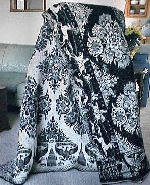
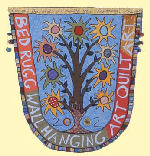 My journey has lead to some very interesting historical tidbits also; one in particular is the early version of a blanket called the the Rugg
My journey has lead to some very interesting historical tidbits also; one in particular is the early version of a blanket called the the Rugg
Image right: Wool, cotton, linen, satin, beads, and buttons. Traditional rug hooking, reverse appliqué, appliqué, couching, beading, braiding, and hand made
pompoms.This piece is about the progression of needlework from utilitarian objects to objects of art. It is also about the growth of women and their status in our country.
From Liz Alpert Fay